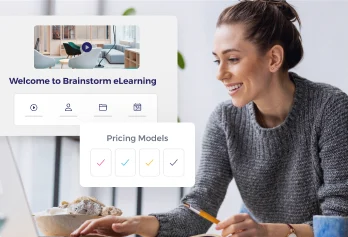Investing in a learning management system (LMS) is a critical decision that can significantly impact your organization's growth, employee engagement, and overall success. According to a study by Bersin by Deloitte, companies with a strong learning culture have a 30-50% higher retention rate and a 46% higher ROI in training.
What we’ve seen at Absorb is that in order to improve ROI, companies must improve their training opportunities as well as track the impact of corporate programs— so organizations thrive with employees and business impact. As a result, companies can discover how effective training was for employees along with its true value to the company moving forward. To maximize the value of corporate learning, it's essential to adopt a strategic approach and use of an LMS to align your training initiatives with your organization's core business objectives.
In this blog post, we’ll explore several strategies to maximize your ROI with an LMS by adopting a vision that focuses on aligning training initiatives with business goals, optimizing learning content, monitoring employee progress, leveraging data and analytics, and refining your training approach. By implementing these strategies, you can unlock the full potential of your organization and empower employees to excel in their roles, contributing to your organization's long-term success.
1. Align training initiatives with business objectives
To ensure maximum return on your corporate learning investment, it's imperative to align your training initiatives with your organization's overarching business objectives. The right LMS can enable you to design and align tailored training programs that cater specifically to your company's goals and strategies:
- Identify key performance ndicators (KPIs): Determine the KPIs that matter most to your organization, such as employee productivity, sales growth, or customer satisfaction, and design your training program to target these key areas.
- Establish clear learning outcomes: Formulate learning outcomes that are closely tied to your business objectives to ensure that your training initiatives are focused on driving success and growth for your enterprise.
- Develop role-specific training: Create targeted training programs for various job roles within your organization based on the skills and competencies required for each position.
- Collaborate with stakeholders: Collaborate with department heads, team managers, and other key stakeholders to ensure that your training initiatives address the critical challenges faced by each business unit.

2. Use common methods of employee training and learning
Effective corporate training is becoming a critical factor for reskilling and upskilling, employee morale and organizational retention rates. But with an abundance of methods to choose from, you need to choose the ones that best support your individual organization and learners. A few of the most common learning and development methods include:
- Instructor-led training: Instructor-led training (ILT) is the most traditional method for employee learning, while it generally occurs at an on-site location it can be part of an eLearning program. ILT may be most effective for complex material because direct interaction and questioning are possible. Due to travel, lodging, facility and material expenses, as well as the time that is needed for each session, this type of training is also the least scalable when it’s the sole training method of an L&D program.
-
Technology-based learning: As technology continues to grow, there are increasingly diverse options to use for online learning, and organizations and their employees often value these opportunities because of the scalability, personalization and flexibility they offer. Some of the most popular online training types, which are most often delivered through a learning management system (LMS), involve:
- eLearning courses
- VILT
- Gamification
- Social learning
- Virtual Reality (VR) and Augmented Reality (AR)
-
On-the-job training: With on-the-job training (OJT), employees can observe the systems and procedures of the workplace and familiarize themselves quickly. As more teams become distributed, there are also ways to do this training online. Common methods for effective employee OJT include:
- Mentoring programs
- Role-Playing
- Shadowing
- Digital apprenticeships
3. Optimize learning content to drive employee engagement
Engaging and interactive learning content is vital to the success of your corporate training program. The Absorb LMS enables you to create immersive and personalized learning experiences that empower your employees to excel in their roles:
- Diverse content formats: Leverage the wide range of content formats supported by Absorb LMS, including videos, e-books, simulations, and podcasts, to cater to the diverse learning preferences of your workforce.
- Microlearning: Embrace microlearning by creating bite-sized learning modules that deliver specific, focused learning objectives, enabling employees to quickly digest information and apply their knowledge.
- Personalized learning paths: Develop individualized learning paths that take into account each employee's unique skill level, role requirements, and learning style for a more relevant and engaging learning experience.
- Continuous content improvement: Periodically review and update your course content based on employee feedback, industry trends, and organizational changes to keep your training programs fresh, relevant, and impactful.
4. Monitor employee progress and provide feedback
Continuous monitoring of employee progress, along with providing constructive feedback, is essential for the success of your training program and maximizing your ROI. The Absorb LMS facilitates regular progress tracking, enabling you to keep employees accountable, identify knowledge gaps, and offer timely support:
- Tracking and reporting: Use the Absorb LMS’ robust tracking and reporting capabilities to monitor employee progress, assess performance, and identify skill gaps that may require additional training or support.
- Automated notifications and reminders: Implement automated notifications and reminders to encourage employees to stay on track with their training and remain accountable for their learning progress.
- Timely feedback: Provide regular feedback to employees on their performance to help them identify areas of improvement and recognize their success in mastering new skills and knowledge.
- Encourage goal setting: Motivate learners to set personal training goals and celebrate their achievements as they progress through their learning paths, instilling a sense of accomplishment and ownership.
5. Leverage data and analytics to refine your training approach
Data-driven insights can be invaluable in helping you refine your training initiatives and ensure their continual improvement. The Absorb LMS provides an array of analytics and reporting tools that enable you to make informed decisions and optimize your corporate learning strategy for maximum ROI:
- Dashboard and reports: Harness the power of your Absorb LMSdashboard to access real-time insights and performance data, helping you identify trends, track training progress, and measure the impact of your efforts.
- Course evaluation: Conduct regular course evaluations to gather employee feedback, identify areas of improvement, and make data-driven adjustments to your learning content and processes.
- Skill gap analysis: Analyze employee skills and competencies to identify critical gaps and opportunities for further training and development.
- ROI assessment: Assess the overall success of your training initiatives by measuring the return on investment in terms of improved employee performance, increased productivity, and other quantifiable metrics.
6. Measuring the ROI of corporate learning
Just as employee learning is an investment by the organization, measuring the return on investment (ROI) of this training is an expenditure of time and money as well. However, both of these actions are a necessity for organizational growth and, if implemented successfully, are profitable and invaluable investments.
The learning ROI formula: The ROI of corporate learning is a valuable way to determine if the organization’s training investment is worthwhile. These calculations are used to discover if employees are learning new skills that increase their efficiency or reduce organizational costs, as well as compare training program costs to the resulting benefits.
The formula most commonly used to determine ROI for corporate training programs is the benefits or net profit of the program minus the training costs divided by the overall program costs:
The result represents the dollar amount returned as a benefit for every dollar spent on the corporate training program. Just multiply the number by 100 to get the ROI percentage.
Additional ways to measure corporate training ROI
A report from EBSCO Connect says that 96% of CEOs want learning and development to be connected to, but only 8% report getting that information. But there are many simple ways to determine the ROI of learning programs that businesses can implement including:
- Using a training ROI calculator: This calculates the ratio of the total cost of the training program relative to the overall benefits of the program.
- Creating an impact study for calculations: An impact study involves going through the phases of evaluation planning, data collection and data analysis.
- Using the Philips ROI methodology: The Philips ROI methodology is a 10-step training evaluation method based on reaction, learning, behavior and results.
- Using supervisor assessments: For more flexible work, such as assessing customer service or teamwork, supervisors can turn observations into a monetary value to calculate ROI.
- Implementing a platform to measure training effectiveness: With the flexible reporting and analytics provided by an LMS, useful reports can be automated and generated for you to simplify the process.
ROIs that signal effective training programs
However you decide to measure ROI, it’s paramount to understand what these numbers mean. Once you’ve converted your ROI to a percentage, you ideally want to see a number over 100%. This means that your training investment had a positive business impact, increasing revenue. A 100% ROI shows a program that earned its money back without increasing revenue, while anything below 100% means money was lost on training.
These interpretations of data are essential for managers to accurately understand the value of their corporate training programs while guiding them to the learning method that will be the most beneficial. But there are additional factors to consider when proving the value and return on training.
Overflow benefits and business impacts to consider
Tracking and measuring the ROI of corporate training helps employers quantify program results, but there are also a host of overflow benefits that employee training investments provide as well. Additional advantages that effective corporate training contributes include:
- Improved employee morale, motivation and satisfaction
- Reduced skill gaps
- Keeping pace with industry trends and changes
- Increased retention and decreased turnover
- Upgraded employee performance
- Enhanced working relationships
For example, maybe your training ROI wasn’t at or above 100%, but through employee feedback survey results and HR insights you connected a positive correlation between your new career development training and a reduction in employee turnover. Considering it costs upwards of $4,400 per new hire and takes an average of 36-42 days to fill a job opening, you could be looking at a larger return than you initially thought.
As corporate learning programs grow in importance, employers must understand the variety of options available to the organization and determine what method or practice would be most effective. In the long run, these programs aren’t a cost to the company, but rather a significant investment for talent development and improved business results.
Achieve Superior and a Forward-Thinking Strategy
By aligning your training initiatives with your business objectives, optimizing your learning content, continuously monitoring employee progress, and leveraging data and analytics, you can maximize your return on investment with the Absorb LMS. Achieving a high ROI in your corporate learning programs translates to improved employee engagement, increased productivity, and sustained growth for your enterprise.
Investing in a powerful and flexible LMS content platform like Absorb LMS, paired with a well-planned, data-driven strategy, will enable you to unleash the potential of your workforce and achieve long-term success in today's competitive business landscape.
Are you ready to maximize your corporate learning ROI and create a more engaged, skilled, and knowledgeable workforce? Discover the power and flexibility of the Absorb LMS — request a demo today!
Learn more about how Absorb LMS powers corporate learning and request a demo today.





